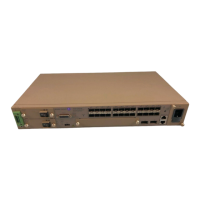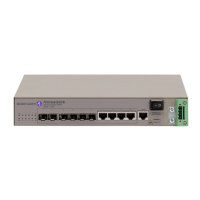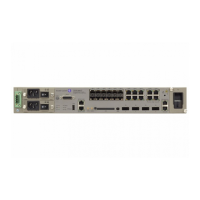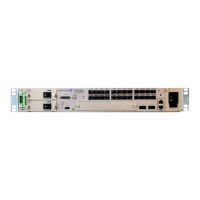LEDs and Optics
Page 114 7450 ESS-7
DCE Flip the switch to DCE when connecting to the serial port of a PC with a
straight-through cable. When the switch is flipped to DCE, the console
port is acting as a data communications equipment (DCE) serial port.
6 Console The console port is provisioned with a DB-9 jack and used for the initial
system startup as well as system configuration and monitoring. The
console port, a Universal Asynchronous Receiver/Transmitter (UART)
port, is used for system configuration and monitoring.
Use a EIA/TIA-232 DCE console cable to connect a terminal to the
console port.
The factory default baud rate is typically 115.2KBaud.
7 AUX The UART Auxiliary (diagnostic) port is provisioned as a DB-9 serial
auxiliary port and is used for modem connection.
8 Alarm The Alarm port is provisioned as a DB-9 serial port and to connect to
external alarm devices that report conditions that trigger red or amber
alarms.
9 ACO/LT The Audible Alarm Cutoff/Lamp Test button verifies the operability of
LEDs. When pressed, the LEDs should temporarily illuminate. This
button also turns off all external alarm relay control bits until the next
new alarm condition.
The LEDs blink when the button is depressed.
10 Mgmt Link
Data
• Amber: 10 Mb/s
• Green: 100 Mb/s
• Unlit: Operationally down.
• Green (blinking): RX/TX activity.
• Amber (blinking): Error condition.
11 Compact Flash #1 (Slot) • Default filename: cf1:
• See the Compact Flash LED description for the status of a compact
flash slot.
• To eject a flash card, gently depress the ejector button until the flash
card releases.
12 Compact Flash #2 (Slot) • Default filename: cf2:
• See the Compact Flash LED description for the status of a compact
flash slot.
• To eject a flash card, gently depress the ejector button until the flash
card releases.
Table 36: SF/CPM Field Descriptions (Continued)
Key Label/Part Sub
category
Description

